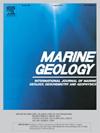被捕获的行为:钙质藻类创造了未描述的中囊藻礁形态
IF 2.2
3区 地球科学
Q2 GEOSCIENCES, MULTIDISCIPLINARY
引用次数: 0
摘要
对利诺萨岛大陆架(地中海西西里岛海峡)的远程操作车辆调查揭示了一种以前未描述的珊瑚藻礁形态。这些生物源固体基质的特征是平面到圆锥形,从单层到多层结构,高程为20-30厘米,凹凸排列。这种珊瑚组合主要覆盖海底深度在80到100米之间,在富含生物成分的沉积基底上发育,特别是丰富的菱形岩。我们记录了珊瑚藻作为自生工程师的作用,在通过藻礁形成将可移动的生物沉积物转化为稳定的基质中,正如海底生物生物学对高原珊瑚藻的理论。本文章由计算机程序翻译,如有差异,请以英文原文为准。
Caught in the act: calcareous algae creating undescribed morphologies of mesophotic algal reef
The exploration of the Linosa Island shelf (Sicily Channel, Mediterranean Sea) by remotely operated vehicle surveys revealed a previously undescribed morphotype of coralligenous algal reef. These biogenic solid substrates are characterized by planar to conical shapes, ranging from single to multilayered structures, with an elevation of 20–30 cm and a concave to convex arrangement. Such coralligenous assemblages primarily cover the seafloor at depths between 80 and 100 m, developing on a sedimentary substrate rich in biogenic components, particularly abundant rhodoliths. We document the role of crustose coralline algae as autogenic engineers, in transforming mobile biogenic sediments into stable substrates by algal reef formation, as theorized by benthic bionomics for the coralligène de plateau.
求助全文
通过发布文献求助,成功后即可免费获取论文全文。
去求助
来源期刊

Marine Geology
地学-地球科学综合
CiteScore
6.10
自引率
6.90%
发文量
175
审稿时长
21.9 weeks
期刊介绍:
Marine Geology is the premier international journal on marine geological processes in the broadest sense. We seek papers that are comprehensive, interdisciplinary and synthetic that will be lasting contributions to the field. Although most papers are based on regional studies, they must demonstrate new findings of international significance. We accept papers on subjects as diverse as seafloor hydrothermal systems, beach dynamics, early diagenesis, microbiological studies in sediments, palaeoclimate studies and geophysical studies of the seabed. We encourage papers that address emerging new fields, for example the influence of anthropogenic processes on coastal/marine geology and coastal/marine geoarchaeology. We insist that the papers are concerned with the marine realm and that they deal with geology: with rocks, sediments, and physical and chemical processes affecting them. Papers should address scientific hypotheses: highly descriptive data compilations or papers that deal only with marine management and risk assessment should be submitted to other journals. Papers on laboratory or modelling studies must demonstrate direct relevance to marine processes or deposits. The primary criteria for acceptance of papers is that the science is of high quality, novel, significant, and of broad international interest.
 求助内容:
求助内容: 应助结果提醒方式:
应助结果提醒方式:


